Economic Costs Of Barriers To Employment For Former Prisoners And People Convicted Of Felonies
Despite modest declines in recent years, the large and decades-long blossoming of the prison population ensure that it will take many years before the United States sees a corresponding decrease in the number of former prisoners. Using data from the Bureau of Justice Statistics (BJS), this report estimates that there were between 14 and 15.8 million working-age people with felony convictions in 2014, of whom between 6.1 and 6.9 million were former prisoners.
Prior research has shown the adverse impact that time in prison or a felony conviction can have on a person’s employment prospects. In addition to the stigma attached to a criminal record, these impacts can include the erosion of basic job skills, disruption of formal education, and the loss of social networks that can improve job-finding prospects. Those with felony convictions also face legal restrictions that lock them out of many government jobs and licensed professions.
Assuming a mid-range 12 percentage-point employment penalty for this population, this report finds that there was a 0.9 to 1.0 percentage-point reduction in the overall employment rate in 2014, equivalent to the loss of 1.7 to 1.9 million workers. In terms of the cost to the economy as a whole, this suggests a loss of about $78 to $87 billion in annual GDP.
Some highlights of this study include:
- Between 6.0 and 6.7 percent of the male working-age population were former prisoners, while between 13.6 and 15.3 percent were people with felony convictions.
- Employment effects were larger for men than women, with a 1.6 to 1.8 percentage-point decline in the employment rate of men and a 0.12 to 0.14 decline for women.
- Among men, those with less than a high school degree experienced much larger employment rate declines than their college-educated peers, with a drop of 7.3 to 8.2 percentage points in the employment rates of those without a high school degree and a decline of 0.4 to 0.5 percentage points for those with college experience.
- Black men suffered a 4.7 to 5.4 percentage-point reduction in their employment rate, while the equivalent for Latino men was between 1.4 and 1.6 percentage points, and for white men it was 1.1 to 1.3 percentage points.
This paper updates earlier CEPR research that also examined the impact of former prisoners and those with felony convictions on the economy.
Introduction
The number of prisoners in the United States has grown dramatically over the past 40 years. In 1980, there were 503,600 people in prisons or jails at the federal, state and local level. By the end of 2014, this number had ballooned to 2,224,400, and an additional 4,708,100 people were on parole or probation at that time. These figures translate to about 1 in 110 adults behind bars and about 1 in 52 adults on parole or probation. Despite small decreases in the share of people in prison or jail in recent years, the United States still has one of the highest incarceration rates in the world, second only to Seychelles.
While this growth in the overall number of prisoners, parolees, and probationers has been documented over time, estimates of the total number of former prisoners and people with felony convictions have been rare. This report builds off of prior CEPR research examining the population of former prisoners and people with felony convictions. It estimates both the size (see Figure 1) and impact of this population on the U.S. labor market.
Time in prison, jail, or even a felony conviction can have a tremendous impact on the lives of former prisoners and people with felony convictions. A criminal record can negatively affect prospects for employment, education, public assistance, and even civic participation by making many people with felony convictions ineligible to vote. Often it is not just the former prisoner or person with felony convictions impacted; the well-being of their families is often threatened. This analysis focuses on the negative effect on the employment prospects of former prisoners and people with felony convictions and the implications for the labor market.
The calculations in this paper indicate that in 2014, the year for which there is the latest available data, the impediments to employment faced by former prisoners and people with felony convictions meant a loss of about 1.7 to 1.9 million workers. This was equal to a roughly 0.9 to 1.0 percentagepoint reduction in the overall employment rate, and a loss of between $78 and $87 billion in GDP.
The uptick in the U.S. incarceration rate and the number of former prisoners and people with felony convictions in the U.S. are a reflection not of a crime rate spiraling out of control, but of significant and often unnecessary changes in the criminal justice system. For example, both violent and property crime rates are much lower today than they were in the 1980s when the incarceration rate began to increase rapidly. Rather, much of the increase in incarceration is due to strict and often harsh sentencing probabilities and sentence lengths. This explosion in the number of people in U.S. prisons and jails has rightly been characterized by Gottschalk as the metastasizing carceral state.
In recent years, there has been broad acknowledgement of the need for reform of the criminal justice system, due in part to the ways in which it has directly contributed to the increase in mass incarceration and the collateral costs that have resulted. Calls to address the severity of policies such as the War on Drugs and the Violent Crime Control and Law Enforcement Act of 1994 have become louder and more critical, from the vocal protests of Black Lives Matter and others to executive orders and legislation from President Obama as well as both Democrats and Republicans in Congress. Estimates of the population of former prisoners and people with felony convictions like the one offered here can play a role in this discussion by demonstrating the negative impact of aggressive and often ineffective incarceration policies on the overall economy.
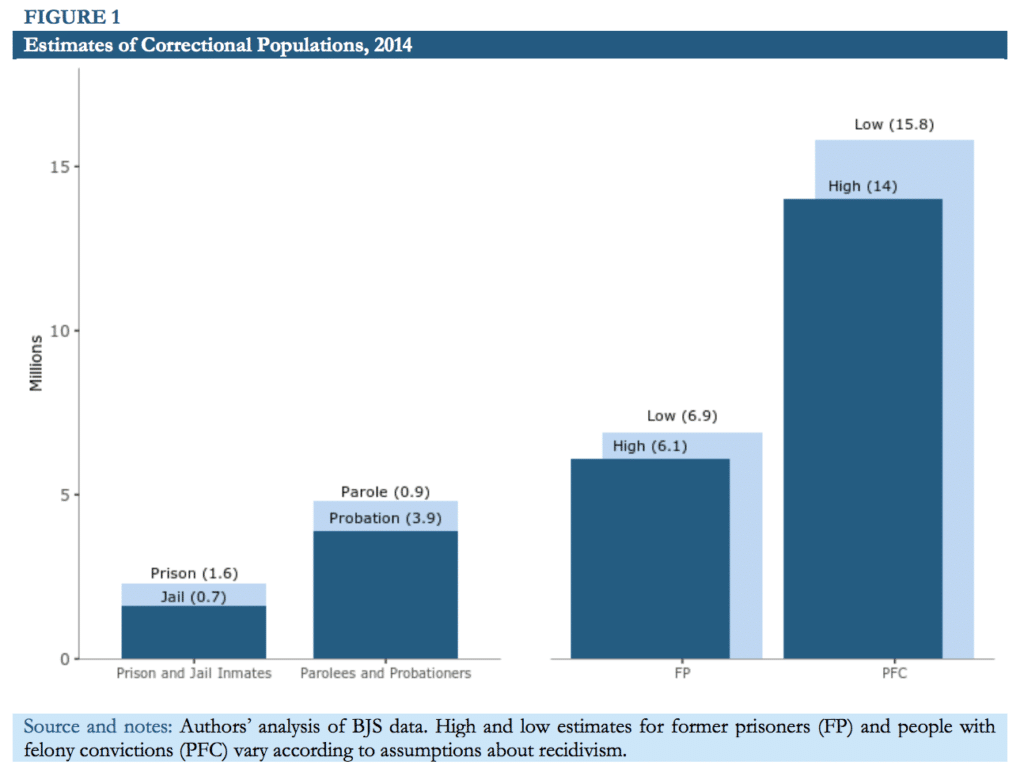
Estimating the Number of Former Prisoners and People with Felony Convictions
There are no publicly available data on the exact size or composition of the population of former prisoners and people with felony convictions. In lieu of that, this paper provides an indirect estimate of the former prisoner population, and uses it to estimate the size and composition of the population of people with felony convictions.
Table 1 displays estimates of the number of former prisoners and people with felony convictions in 2014. These estimates are based on an analysis of Bureau of Justice Statistics data that count the number of prisoners released each year from 1968 to 2014. Assuming that the age and gender distributions of released prisoners are the same as the overall prison population, this report “tracks” each yearly cohort of released prisoners over time. As it is only concerned with the working-age population (ages 18 to 64), it allows former prisoners to age out once they reach age 65. Then, agegroup-specific return-to-prison recidivism rates are applied to isolate the former prisoners who do not return to prison. Here, there is use of both a low and a high measure of the recidivism rate to account for returns that occur after three years.
Next, an estimate of age-specific death rates are applied, adjusting up accordingly, to account for the high-risk population of this study. 14 The first two columns of Table 1 imply that the former prisoner population in the U.S. in 2014 was between 6.1 million (using a high recidivism rate) and 6.9 million (using a low recidivism rate). See the Appendix for further details on this estimation technique.
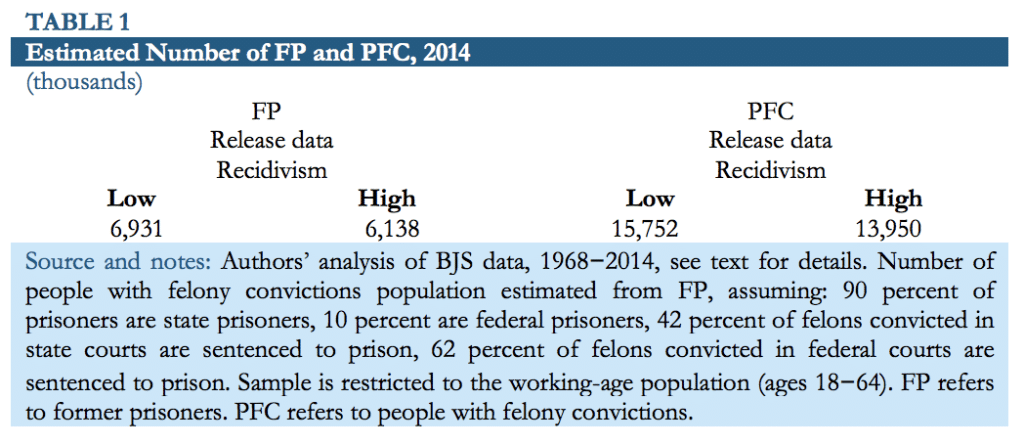
In the past, researchers have attempted to estimate the former prisoner population. This paper uses the same methods of Schmitt and Warner (2010). Their report focused on the population of former prisoners and people with felony convictions in 2008, and their results showed that there were between 5.4 and 6.1 million former prisoners of working age in 2008. Forecasts made by Bonczar (2003) imply that there would be about 5.7 million former prisoners in 2008 and 6.2 million former prisoners in 2010. Extending the methods from this report back to 2010, there were approximately between 5.6 and 6.3 million former prisoners in 2010. To the best of the authors’ knowledge, there have not been any attempts to estimate the size or characteristics of the former prisoner population since 2010. However, the methods used in this paper are the same as those used by Schmitt and Warner (2010), which had results that were broadly consistent with the other estimates mentioned.
The final two columns of Table 1 show estimates of the number of people with felony convictions.
Again, there are no direct estimates of this population, but this report uses administrative data on the percent of felons sentenced to prison, in addition to the estimates of the former prisoner population presented in this paper to arrive at estimates of the number of people with felony convictions. About 44 percent of felons are sentenced to prison. The approach used in this paper estimates that there were between 14.0 million and 15.8 million people with felony convictions in 2014. In their earlier report using the same methods, Schmitt and Warner (2010) estimated that there were between 12.3 million and 13.9 million people with felony convictions in 2008.
In addition to estimates of the number of former prisoners and people with felony convictions, another goal of this paper is to determine their demographic characteristics. To estimate these characteristics, this report first uses the demographic characteristics of current prisoners for selected years and applies these estimates to the population of former prisoners and people with felony convictions. Table 2 shows various characteristics of the prisoner population for selected years from 1960 to 2014. For all years, the male prisoner population greatly outnumbered the female prisoner population, with men making up at least 93 percent of the population in all years displayed. In 2014, men made up 93.0 percent of the prison population, and this percentage has remained mostly steady since 2000.
Education level, race, and age breakdowns are also displayed for the male prison population. Male prisoners are considerably less educated than the overall male working-age population, with over 85 percent having a high school degree or less. In 2014, about 43 percent of the overall working-age male population had a high school degree or less. During the same year, 97.4 percent of male prisoners were of working age, and 31.9 percent were between the ages of 25 and 34. Also in 2014 36.9 percent of male prisoners were Black, 32.3 percent were white, and 22.0 percent were Latino.
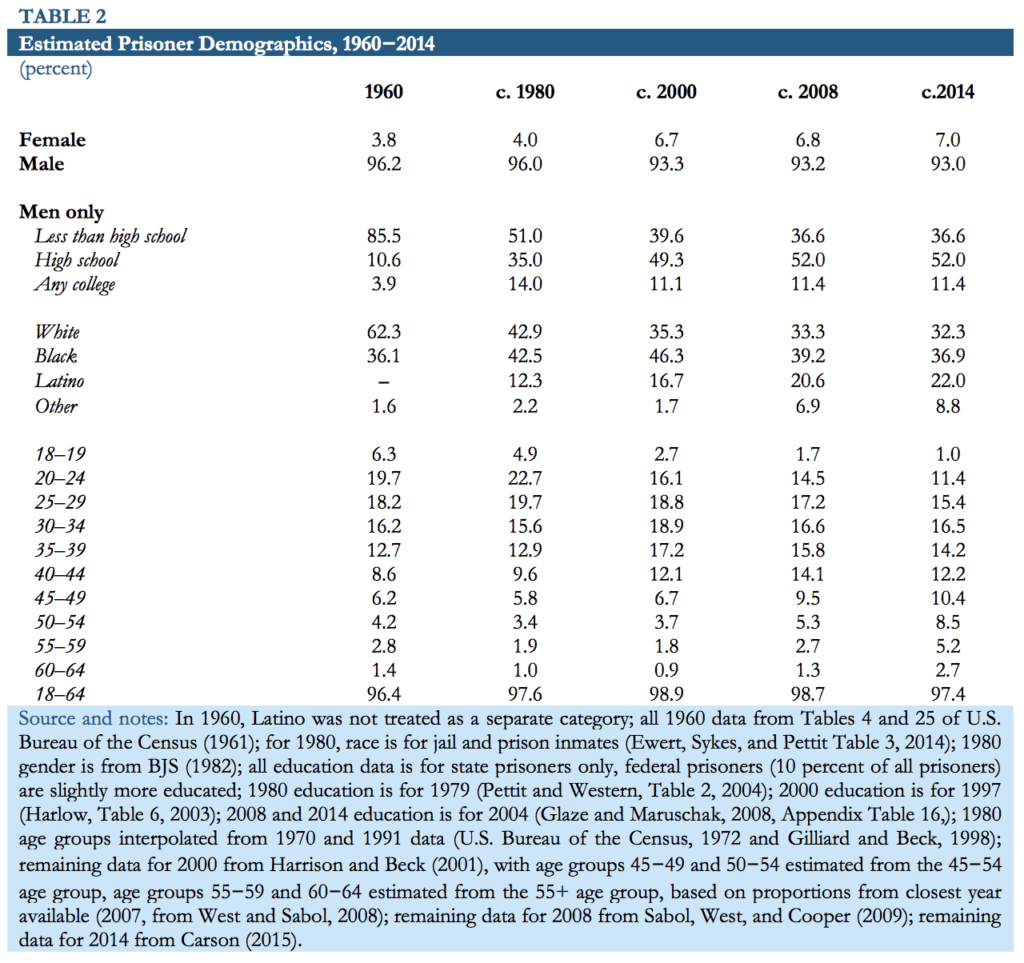
Using the data from Table 2 on the prisoner population, estimates of the demographic characteristics of the entire population of former prisoners and people with felony convictions were created, adjusting for racial differences in recidivism rates and imprisonment rates conditional on felony conviction. Table 3 displays these estimates. According to this data, in 2014 between 448,000 and 506,000 former prisoners were women, and between 1.0 and 1.2 million people with felony convictions were women. Between 5.7 and 6.4 million former prisoners were men, and between 12.9 and 14.6 million people with felony convictions were men. Among male former prisoners, between 2.6 and 2.9 million had less than a high school degree.
There were notable differences in the racial composition of the population of male former prisoners and people with felony convictions. There were more Blacks than whites in the former prisoner population, but there were over 1 million more whites than Blacks in the population of people with felony convictions. This is the result of disparate sentencing rates between the two races. About 49 percent of Black felons are sentenced to prison, while only about 38 percent of white felons are sentenced to prison.19 In 2014, there were approximately between 2.1 and 2.4 million white male former prisoners and between 5.6 and 6.4 million white males with felony convictions. During the same year, there were between 2.2 and 2.5 million Black male former prisoners, and between 4.5 and 5.1 million Black males with felony convictions in the United States.
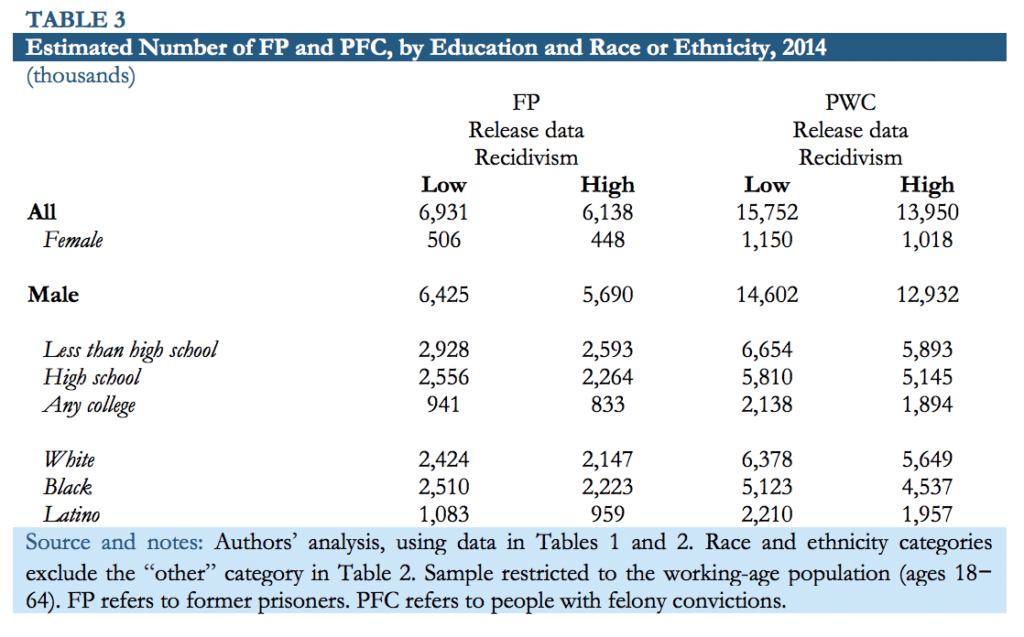
The Effects of Imprisonment and Felony Conviction on Subsequent Employment
A large body of evidence demonstrates that prison time and felony convictions can have a lasting and profound effect on future prospects for employment. In addition to the stigma attached to a criminal record, these impacts include the erosion of basic job skills, disruption of formal education, loss of networks that can improve job-finding prospects, or deterioration of “people skills.” Schmitt and Warner’s review of longitudinal surveys, employer surveys, audit studies, aggregated geographic data, and administrative data suggests that time behind bars can have a significant effect on the employment of those with prison experience or felony convictions. Similarly, a recent review of the literature by Travis, Western and Redbum (2014) discussed the potential supply-side effects and added that “repeated encounters with rejection may lead to cynicism and withdrawal from formal labor market activity.” And while much of the literature on the effects of incarceration focuses on men, Decker, Spohn, Ortiz and Hedberg (2014) find in their study that incarceration has a negative impact on employment for women as well. These hurdles to employment can create an unfortunate cycle as Berg and Huebner (2011) note that post–incarceration employment significantly lowers the chances of recidivism.
Assessment of Employment Effects
The employment effects of incarceration or a felony conviction vary based on the research techniques used, the population researched, and the metrics that describe the employment impact. For the most part, the research shows a moderate to large impact on the employment levels of former prisoners and people with felony convictions. However, this report is concerned with an estimate of the impact of the population of former prisoners and people with felony convictions on the employment levels of all working-age adults, which is somewhat outside the scope of much of the research on incarceration and employment. Longitudinal surveys of individuals capture much of the data necessary for the analysis in this paper and typically yield moderate to large effects on employment levels. Employer surveys and audit studies also show a large impact on employment levels but are less useful for this present analysis. Aggregate state-level data, though less-directly applicable, show small to moderate effects. Administrative studies, while more in line methodologically with longitudinal studies, have technical difficulties and produce results that are inconsistent with other available data.
To better estimate the impact on employment levels while considering these methodological differences, this paper uses the three separate estimates employed by Schmitt and Warner (2010). The estimates examine low-, medium-, and high-effects scenarios to develop estimates of the employment effects of incarceration. Like Schmitt and Warner:
“In the low-effects scenario, we assume that ex-prisoners or ex-felons pay an employment penalty of five percentage points (roughly consistent with the largest effects estimated using administrative data and the lower range of effects estimated using the aggregate data and survey data). In the mediumeffects scenario, we assume that the employment penalty faced by ex-prisoners and ex-felons is 12 percentage points, which is consistent with the bulk of the survey-based studies. In the high-effects scenario, we assume that the employment penalty is 20 percentage points, which is consistent with the largest effects estimated in the survey-based studies, as well as, arguably, the findings of the employer surveys and audit studies.”
Estimating the Impact of Former Prisoners and People with Felony Convictions on Total Employment and Output
Here, this report estimates the effect of the population of former prisoners and people with felony convictions on total employment and output. To do so, this report uses the estimates of the population of former prisoners and people with felony convictions and the outside estimates of the employment penalty faced by those with prison experience or a felony conviction from the previous two sections of this paper.
First, the size and demographic characteristics of the population of former prisoners and people with felony convictions from Table 3 are compared to the overall civilian, non-institutional workingage population. Table 4 displays estimates of the population of former prisoners and people with felony convictions as a share of the total working-age population in 2014. Overall, former prisoners were between 3.2 and 3.6 percent of the non-institutional working-age population. People with felony convictions were between 7.2 and 8.1 percent. As with those currently behind bars, former prisoners and people with felony convictions are much more likely to be men than women. In 2014, an estimated 6.0 to 6.7 percent of the working-age male population were former prisoners, and between 13.6 and 15.3 percent were people with felony convictions. On the other hand, between 0.45 and 0.51 percent of working-age women were former prisoners, and between 1.0 and 1.2 percent were people with felony convictions.
There were also notable differences by education level and race, although these estimates are less precise than those above. Between 26.6 and 30.1 percent of men with less than a high school degree were former prisoners, and between 60.5 and 68.3 percent were people with felony convictions. By contrast, only between 1.5 and 1.7 percent of men with any college experience were former prisoners and between 3.5 and 3.9 percent were people with felony convictions. Black men were more likely than their white or Latino counterparts to be former prisoners or people with felony convictions. Between 19.4 and 21.9 percent of Black men were former prisoners, and between 39.5 and 44.6 percent were people with felony convictions.
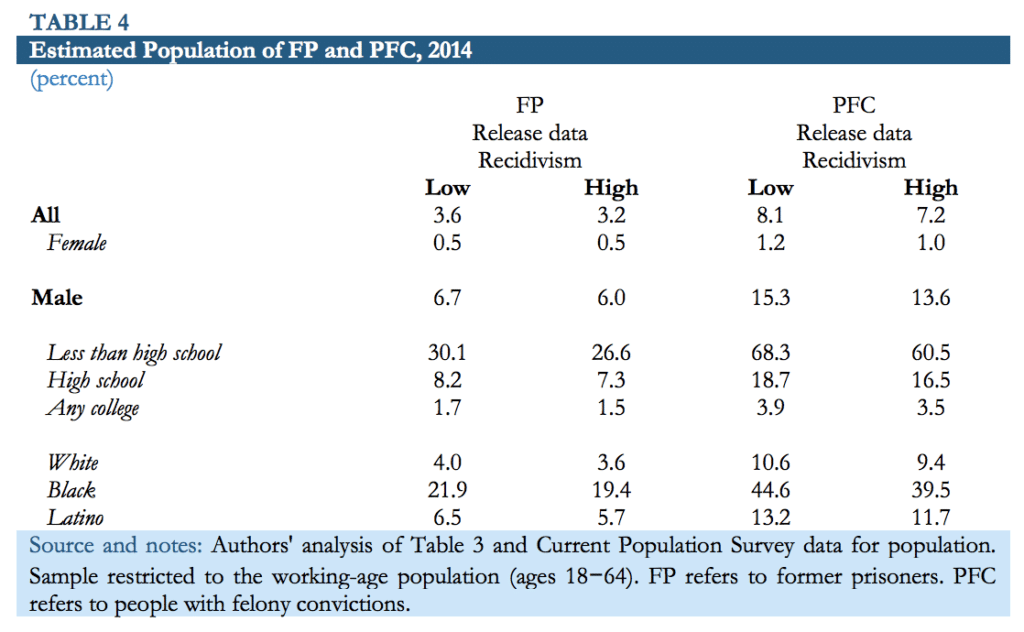
The calculations in Table 4 are then used to determine the reduction in the overall employment rate that occurs as a result of the employment penalty for former prisoners and people with felony convictions. Table 5 shows the results of this exercise for men. Three separate sets of measures are displayed. The first assumes a low, 5 percentage-point employment penalty compared to a similar worker with no prison experience or felony conviction. The second set of measures assumes a medium, 12 percentage-point employment penalty, and the last set assumes a high, 20 percentagepoint employment penalty.
Assuming a low employment penalty of 5 percentage points, the population of former prisoners and people with felony convictions lowered the employment rate of men by between 0.3 and 0.8 percentage points in 2014. Assuming a medium, 12 percentage-point employment penalty, the population of former prisoners and people with felony convictions lowered the employment rate of men by between 0.7 and 1.8 percentage points. With a high employment penalty of 20 percentage points, this population lowered the employment rate of men by between 1.2 and 3.1 percentage points.
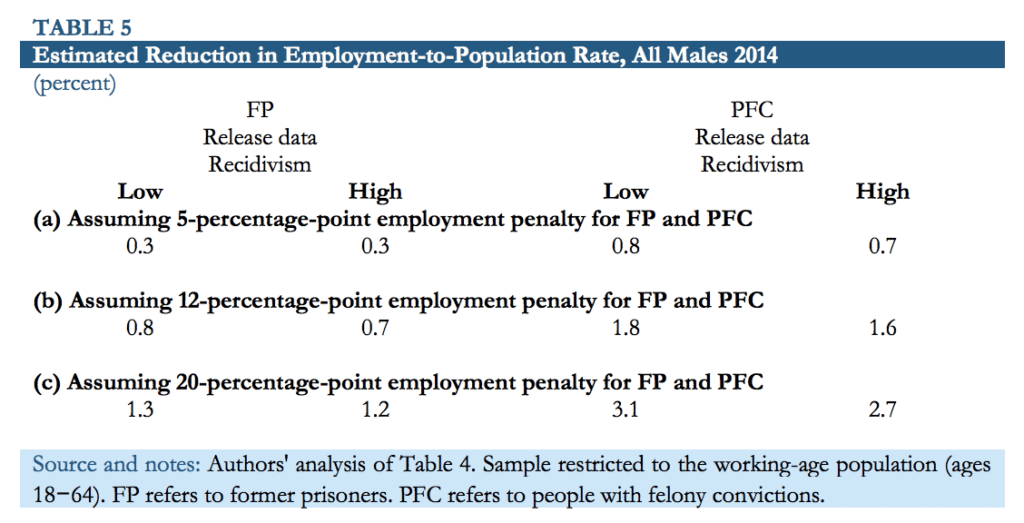
Table 6 displays the estimated decline in overall employment rates in 2014, with various demographic breakdowns. These estimates assume a medium, 12 percentage-point employment penalty for former prisoners and people with felony convictions. They show that the population of former prisoners and people with felony convictions reduced the overall employment of the working-age population by between 0.4 and 1.0 percentage points. The impact was particularly large for Black men and men with less than a high school degree. The population of former prisoners and people with felony convictions lowered the employment rates of Black men by between 2.3 and 5.4 percentage points. This population also lowered the employment rates of men with less than a high school degree by between 3.2 and 8.2 percentage points.
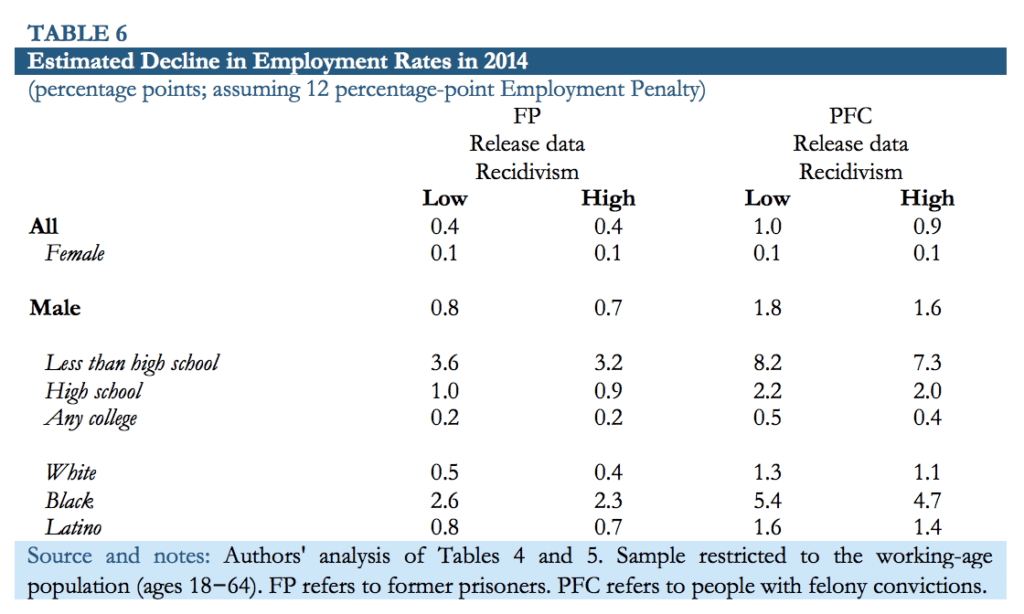
The results presented in this paper show how contact with the criminal justice system in the form of a felony conviction or imprisonment can affect the future employment prospects of former prisoners and people with felony convictions. In addition to the likely large reductions in personal earnings as a result of these employment penalties, the economy as a whole suffers from a reduction in output. More specifically, this report estimates that the population of former prisoners and people with felony convictions cost the U.S. about 0.45 to 0.5 percentage points of GDP in 2014, or about $78.1 to $86.7 billion.
Conclusion
This paper examines the labor market impact of the growing number of individuals who have been imprisoned or have felony convictions. The findings presented in this paper show that, in 2014, overall employment rates were 0.9 to 1.0 percentage points lower as a result of the employment penalty faced by the large population of former prisoners and people with felony convictions. For men, their employment rate was 1.6 to 1.8 percentage points lower and for men with less than a high school degree, their employment rate was 7.3 to 8.2 percentage points lower.
However, it is not just the individual that suffers; the impact is felt across the U.S. labor market. In terms of GDP, the calculations in this report suggest that the population of former prisoners and people with felony convictions led to a loss of $78 to $87 billion in GDP in 2014. While there has recently been a push from advocates and policy-makers alike to re-examine sentencing policy and practice, the negative impacts on former prisoners and people with felony convictions themselves and the economy as a whole will grow in scale unless the burgeoning reform trend continues and accelerates.
This report has been altered for publication on The Sanders Institute website. To read the full report with the Appendix click here.

